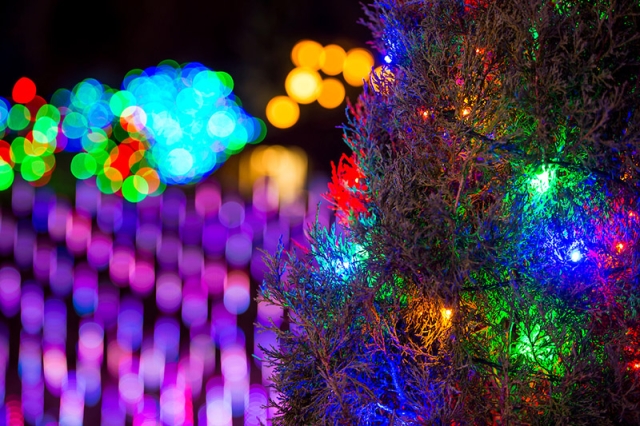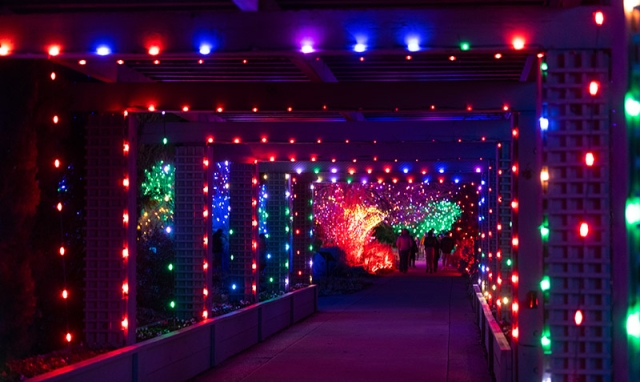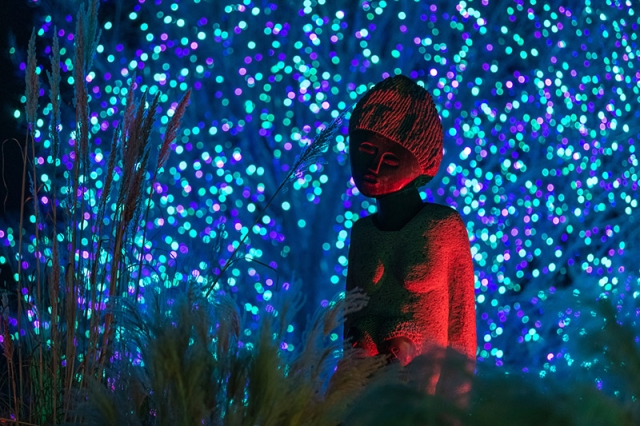The Luminous History of Holiday Lights
Installation of Blossoms of Light™, our annual holiday light show at the Gardens' York Street location, is no easy feat! We estimate that around half a million bulbs are used to create the spectacular winter display. Working with all these lights made us wonder: How did the light bulb make its way from our kitchen ceilings to Christmas trees and housing exteriors everywhere? We dug into the history of the humble holiday string light and how we went from lighting candles on evergreen trees to explosive holiday displays all over the world.

Christmas trees used to be decorated with candles. Bringing trees inside for winter holidays comes from a combination of German and Dutch traditions from the 15th and 16th centuries. Illuminated Christmas trees may also have some roots tied to the pagan festival of Yule. During this celebration of the winter solstice, lighting a yule log scared off evil spirits that might be afoot on long winter nights. The tradition of lighting a yule log on Christmas Eve continued through the 19th century.
As one may imagine, open flames and a dry evergreen tree can be a bit of a fire hazard. However, thanks to Edwards Johnson, associate of Thomas Edison, holiday lights were on their way to replacing Christmas tree candles. In 1882, Johnson set out his first Christmas tree displayed with an electric string of lights in his New York City parlor. Johnson’s string of lights was constructed with a single wire and 80 red, white and blue light bulbs.
The electric string light wouldn’t catch on for a few more years; consumers remained skeptical of electricity and the cost of lights was a bit high. During the time, string lights with 16 bulbs cost around $12 or a little over $300 dollars in today’s money. However, in 1895 President Grover Cleveland used string lights to decorate the White House Christmas tree and string lights rose in popularity. Then, in the early 1900s, string lights became more affordable to the average consumer. By 1914, a 16-foot string of lights cost about $1.75.

With their increased popularity in the United States, holiday lighting displays began to pop up across the country. In the 1920s, lighting shows displayed larger holiday items such as saints, snowmen and Santa Claus, as well as string lights. While the use of holiday lights continued to rise for the next few decades, the industry soon faced a dip in purchases. In the 1950s the aluminum tree became a popular Christmas choice with consumers inspired by the space age for their interior decorating. The detour for holiday lights didn’t last for long, however; starting in the 1960s, GE looked overseas to manufacture miniature lighting sets. These mini lights more closely resembled the holiday lights we’re familiar with now. The mini lights came in lower wattage, cost less and were outdoor-friendly, allowing more families and businesses to use the lights when decorating outside.
While we’ve held onto the general shape and performance of the mini light, holiday lights continued to be renovated and reimagined as time went on, leading us to the LED lights we know and love today. Unlike the mini lights, LEDs use up to 95 percent less energy and last longer than the general bulb; that’s not to mention your string of lights will continue to work even after a single bulb goes out.

Like the lighting displays found throughout Blossoms of Light, there’s much to be explored and reimagined when it comes to holiday lights and where they will go next. Be sure to catch Blossoms of Light at our York Street location, now open through January 16.
Get tickets and more information about Blossoms of Light. Advance online ticket purchases required; capacity is limited.
Are you looking for a holiday lights experience in Littleton, CO? Visit Trail of Lights at Chatfield Farms.
Add new comment